Vocabulary
Cross Product- The product of one numerator and the opposite denominator in a pair of equivalent
fractions.
Examples
Solving proportions is simply a matter of stating the ratios as fractions, setting the two fractions equal to each other, cross-multiplying, and solving the resulting equation. You'll probably start out by just solving proportions, like this:
- Find the unknown value in the proportion: 2 : x = 3 : 9.
- 2 : x = 3 : 9
- .
9(2) = x(3)
18 = 3x
6 = x
- Find the unknown value in the proportion: (2x + 1) : 2 = (x + 2) : 5
- (2x + 1) : 2 = (x + 2) : 5
ADVERTISEMENT
|
|
5(2x + 1) = 2(x + 2)
10x + 5 = 2x + 4
8x = –1
x = –1/8
Once you've solved a few proportions, you'll likely then move into word problems where you'll first have to invent the proportion, extracting it from the word problem, before solving it.
- If twelve inches correspond to 30.48 centimeters, how many centimeters are there in thirty inches? I will set up my ratios with "inches" on top, and will use "c" to stand for the number of centimeters for which they've asked me.
12c = (30)(30.48)
12c = 914.4
c = 76.2
- Thirty inches corresponds
to 76.2 cm.
- A metal bar ten feet long weighs 128 pounds. What is the weight of a similar bar that is two feet four inches long?
- First, I'll need to convert
the "two feet four inches" into a feet-only measurement. Since
four inches is four-twelfths, or one-third, of a foot, then:
- 2 feet + 4 inches = 2 feet + 1/3 feet = 7/3 feet

- The bar will weigh 448/15 , or about 29.87, pounds.
- The tax on a property with an assessed value of $70 000 is $1 100. What is the assessed value of a property if the tax is $1 400? I will set up my ratios with the assessed valuation on top, and I will use "v" to stand for the value that I need to find. Then:
98 000 000 = 1 100v
89 090.909 090 9... = v
- Since the solution is
a dollars-and-cents value, I need to round the final answer to two decimal
places:
Copyright
© Elizabeth Stapel 2001-2011 All Rights Reserved
- The assessed value
is $89
090.91.
- One piece of pipe 21 meters long is to be cut into two pieces, with the lengths of the pieces being in a 2 : 5 ratio. What are the lengths of the pieces?
- I'll label the length
of the short piece as "x".
Then the long piece, being the total piece less what was cut off for
the short piece, must have a length of 21
– x.
- (short piece) : (long piece):
2 : 5 = x : (21 – x)
2(21 – x) = 5x
42 – 2x = 5x
42 = 7x
6 = x
- 21 – x = 21 – 6 = 15
- The two pieces have
lengths of 6 meters and 15 meters.
http://www.purplemath.com/modules/ratio4.htm
Video Help
https://www.khanacademy.org/math/algebra-basics/core-algebra-linear-equations-inequalities/ratios-core-algebra/v/find-an-unknown-in-a-proportion
https://www.youtube.com/watch?v=he8Gl03cZHg
https://www.youtube.com/watch?v=kAW-JB1IVxA
No comments:
Post a Comment